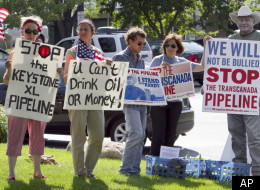Keystone XL Pipeline Obama's 'Biggest Climate Test,' Green Groups Say
Wednesday, August 24, 2011

A Few Facts About Nebraska SandHills:
Beyond the potential harm to global climate systems, the TarSands project poses additional risks to vital fresh water aquifers along the route through US states.KEEP READING
The SandHills are the major recharge zone for the Ogallala (or HighPlains) aquifer. That’s where water goes into the system to (hopefully ) replace what we take out via wells.
The SandHills are also the largest “grass stabilized” dune field in the world, and without the grasses, they would be the largest sand dune field in the WesternHem isphere. The soils are very very sandy and porous, allowing quick and efficient infiltrati on of any fluids that happen to impinge upon them. My colleague and I have just made the first measuremen ts of the recharge rate (although only at a single point) in the region, and I have a pretty good idea of how easily things can work their way down to the water table (i.e. the aquifer).
Probably the thing about the XL pipeline that scares me the most is the potential for one or more “small” leaks. A small leak in the buried pipeline (several barrels per day) would probably go unnoticed for a long time. The monitoring equipment at the pumping stations are designed to read and control flows of thousands and thousands of barrels per day, and a leak of just a few or maybe even ten just wouldn’t register. In that case, oil/tar would leak, and leak, and leak, mostly unnoticed. It probably wouldn’t be discovered until the plume worked its way 12 or so feet up to the surface, and then only if someone happens upon the site. Most places in the SandHills see very little human traffic. This scenario could dump hundreds or thousands of barrels of oil before it’s ever noticed.
Once in the soil, the sands will act somewhat like a refinery. The lighter fractions (benzene, toluene, heptane, etc) will very quickly infiltrate downward to the water table, then it’s not just a soil clean up. It’ll require the pumping and treatment of millions of gallons of water.
Read the Article at HuffingtonPost










0 comments:
Post a Comment